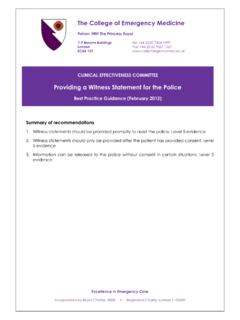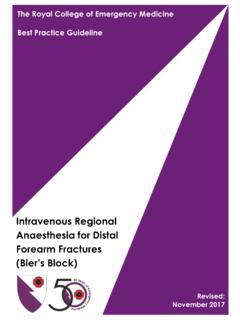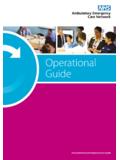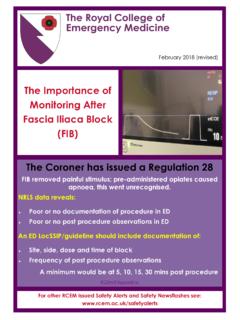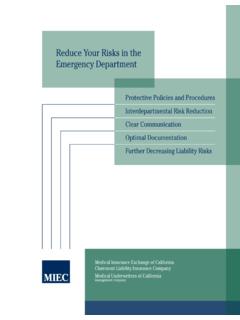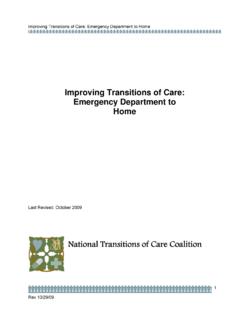Transcription of Initial Assessment of Emergency Department Patients
1 SafeEfficientEffectiveCare Service Design and Delivery Initial Assessment of Emergency Department PatientsInitial Assessment of Emergency Department Patients (February 2017) Page 2 Introduction Patients who present to the Emergency Department (ED) are typically unselected on arrival, although some may have already been seen by a clinician, or have been directed to the Department following a pre-hospital Assessment such as NHS111. A critical function of all EDs is to have reliable processes that can sort Patients , in accordance with their clinical need. These processes are likely to vary between Urgent and Emergency Care systems because of the differences between such systems in different locations. There is not, therefore, a one size fits all approach. This document aims to offer general principles to underpin local processes, and to standardise the terminology used. Summary of key recommendations The front door of the Emergency Department should be managed by the ED and fall within its quality improvement and governance systems Gatekeeping to the ED by non- Emergency Department services is not supported Triaging Patients is appropriate where demand outstrips the resources required to make a detailed Assessment in a timely fashion (usually within 15 minutes or less) Emergency Departments use simple or complex streaming, as part of their Initial Assessment processes.
2 Both processes should be resourced to meet variation in demand, and be delivered by trained clinical staff. Navigation to other services , may precede streaming. However, safety may be improved if streaming is used as an alternative. The use of rapid Assessment systems for ambulatory or trolley Patients is a matter for local decision making. Such systems require dedicated resources. The use of Early Warning Scores in the ED as part of Initial Assessment processes is supported. Early Warning Scores should not be used as a sole measure of acuity, or as the basis for triage / streaming / Assessment decisions. Scope of document This document defines and describes processes currently being used to deliver Initial Assessment of Emergency Department Patients . It replaces and builds on the Triage Position Statement published by The Clinical Effectiveness Committee of the College of Emergency Medicine (and ENCA, FEN and RCN) in April 2011.
3 It recognises that the systems utilised have altered and evolved, and will continue to do so. There is also a recognition that a paucity of good quality research into this area makes the provision of advice based on high quality evidence difficult. The Initial Assessment of Patients during a Major Incident is not covered by this document. Initial Assessment of Emergency Department Patients (February 2017) Page 3 Initial Assessment Objectives of Initial Assessment There are three main objectives of good quality Initial Assessment : 1. Improving safety 2. Identifying acuity to ensure that the most time-critical Patients are treated by the right service within appropriate time frames, and that appropriate prioritisation occurs for the remainder. 3. Improving efficiency in the system to ensure that Patients do not wait unnecessarily for investigations or diagnostic decision making. All the Assessment processes described below incorporate these objectives to varying degrees.
4 Key principles The front door of the Emergency Department should be managed by the ED and fall within its quality improvement and governance systems Where clinicians from other services work within Initial Assessment systems there should be joint development of those systems, and shared governance arrangements. Any process of navigation or streaming, should be designed so that patient safety is paramount. Any Initial Assessment process should improve the quality of care provided for Patients If Patients are advised to attend the ED by other NHS services , navigation and streaming decisions should acknowledge this. Linkage with the rest of the system In an ideal system ED Initial Assessment would be linked to pre-hospital Assessment and triage, although the risk of diagnostic anchoring, and confirmation bias, should be acknowledged, and Assessment should be repeated to detect any deterioration. Access to patient records and notes is helpful.
5 Initial Assessment of Emergency Department Patients (February 2017) Page 4 Gatekeeping vs navigation vs streaming Gatekeeping by non- Emergency Department services Patients who self-refer, are referred by NHS111 or primary care or are conveyed to ED by ambulance, should not be further assessed by any third party service. Such gatekeeping is potentially unsafe and may lead to treatment delays. Registration RCEM recommends that all Patients attending the Emergency Department should be registered within five minutes of arrival. Queues for registration should be actively managed to avoid occult waits for triage. Should navigation occur ahead of registration, the contact should be recorded irrespective of the patient disposition, and this record should be linked to any subsequent ED notes, to ensure that an audit trail is maintained. Navigation Navigation refers to the process of directing Patients to appropriate services prior to a formal process of clinical Assessment .
6 Navigation should not involve redirection to off-site services . Navigation is best and most safely undertaken by a clinician ( an experienced nurse). This function may sometimes be performed by a non-clinician, provided safeguards exist to minimise risk to the patient. For instance, a receptionist may navigate a patient to a co-located Urgent/Primary Care Centre based on a clear set of written criteria, with joint governance arrangements, provided the wait to be seen in that locality is not excessive and the criteria and outcomes are regularly reviewed to ensure safety. Non-clinical staff undertaking navigation should be trained and assessed in the use of appropriate criteria, in order to minimise the clinical risk to the patient ( Patients presenting with chest pain should be assessed urgently by a clinician). RCEM strongly recommends that the norm for navigation is it is undertaken by clinically trained staff. When implementing navigation any perceived advantages should be weighed against possible risks, and consideration given to implementing simple streaming as an alternative.
7 Initial Assessment of Emergency Department Patients (February 2017) Page 5 Streaming Streaming is the process of allocating Patients to different physical areas / services , pathways or processes, in order to improve efficiency and effectiveness. The main objective of streaming is to ensure that the patient is directed to the correct location / service and to the correct person to manage their clinical needs. Streaming should always be performed by a trained clinician. Streaming may include streaming to co-located or specialist services ( co-located primary care services , ophthalmology services ). Patients may be streamed (redirected) to off-site services . For streaming to be effective it needs to be brief, in order to avoid queues developing. However, the overall system used must incorporate safeguards to provide further Assessment of those Patients in whom it is clinically required. Simple Streaming Simple Streaming is based on a clinical Assessment alone.
8 Good quality streaming will typically involve taking a brief history and performing basic observations. Streaming may be combined with triage, and calculation of an EWS for appropriate Patients . Undertaking basic first aid measures, providing simple analgesia and simple tests ( a capillary blood glucose or urine HCG) in this setting is reasonable, however commencing complex investigations is not. Simple streaming will enable the streamer to direct the patient into the appropriate physical area of the Department , in order to match the patient s needs to departmental capability. The process of triage, followed by streaming to majors or minors etc., represents the simplest form of streaming Simple streaming may also involve direction of Patients to co-located or specialist services . Complex Streaming More advanced, or complex, streaming refers to the process of Assessment in which there is a more detailed Assessment of the patient.
9 Complex streaming involves an Assessment of priority and acuity as well as ensuring the patient is managed by the correct service within the correct timeframe. In addition, there is the initiation of investigations (such as requesting blood or radiological tests) that aims to bring the clinical decision making processes forward. Streaming Standard Streaming should be performed as soon as possible and ideally be within 15 minutes of the patient s arrival in the ED. For this to be achieved capacity must be planned to meet variation in demand, and not average demand. Initial Assessment of Emergency Department Patients (February 2017) Page 6 Rapid Assessment systems See and Treat See and Treat refers to a system of directly seeing Patients who have been deemed to be presenting with a minor illness or injury, without further triage or Assessment . The advantage of this is that they are seen directly by a single, appropriately trained clinician, who can complete the episode of care for that patient.
10 Patients may be navigated to the See and Treat stream using appropriate protocols. Patients may also be streamed to See and Treat. However, the Department must ensure that safeguards are in place to ensure that Patients who require immediate attention are not waiting in the See and Treat stream at any time. See and Treat Standard Patients waiting to be seen in the See and Treat stream should not wait for longer than one hour to be seen. If the wait is longer than this, the Patients should have an Assessment by a clinician (triage, streaming etc.). Senior Doctor Triage (SDT), Rapid Assessment and Treatment (RAT) and Early Senior Assessment (ESA) Senior Doctor Assessment , Rapid Assessment and Treatment and Early Senior Assessment all describe the same process: a senior clinician is based as far forward in the ED process as possible, and sees the patient as soon as possible after their arrival. That clinician (typically, but not exclusively, a senior Emergency Department doctor) can make decisions about that patient s care and disposition much earlier in the patient s stay than would have previously been the case.

